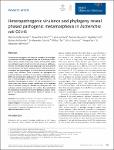Heteropathogenic virulence and phylogeny reveal phased pathogenic metamorphosis in Escherichia coli O2:H6
Bielaszewska, Martina
Schiller, Roswitha
Lammers, Lydia
Bauwens, Andreas
Fruth, Angelika
Middendorf, Barbara
Schmidt, Alexander
Tarr, Phillip I.
Dobrindt, Ulrich
Karch, Helge
Mellmann, Alexander
Extraintestinal pathogenic and intestinal pathogenic (diarrheagenic) Escherichia coli differ phylogenetically and by virulence profiles. Classic theory teaches simple linear descent in this species, where non-pathogens acquire virulence traits and emerge as pathogens. However, diarrheagenic Shiga toxin-producing E. coli (STEC) O2:H6 not only possess and express virulence factors associated with diarrheagenic and uropathogenic E. coli but also cause diarrhea and urinary tract infections. These organisms are phylogenetically positioned between members of an intestinal pathogenic group (STEC) and extraintestinal pathogenic E. coli. STEC O2:H6 is, therefore, a ‘heteropathogen,’ and the first such hybrid virulent E. coli identified. The phylogeny of these E. coli and the repertoire of virulence traits they possess compel consideration of an alternate view of pathogen emergence, whereby one pathogroup of E. coli undergoes phased metamorphosis into another. By understanding the evolutionary mechanisms of bacterial pathogens, rational strategies for counteracting their detrimental effects on humans can be developed.
No license information

